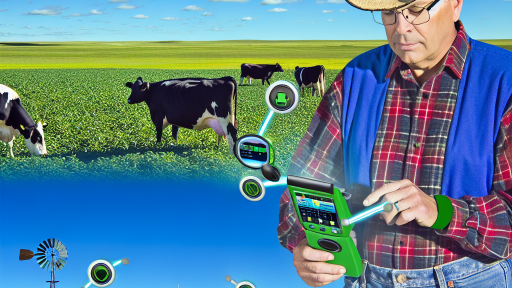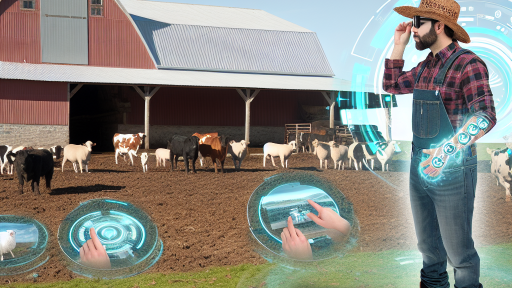Introduction
Disease prevention is crucial in cattle farming.
A healthy herd leads to higher productivity and better livelihoods.
When diseases strike, they can devastate livestock health and farm finances.
Diseases decrease milk production and weight gain, ultimately affecting profits.
Moreover, outbreaks can require costly treatments and reduce marketability.
Several diseases can quickly spread in a herd, requiring careful management.
Producers must recognize the signs of diseases early to reduce outbreaks.
Timely intervention safeguards both animal welfare and farm productivity.
Implementing sound prevention strategies helps maintain herd health and ensures sustainable farming practices.
This blog aims to equip cattle farmers with essential knowledge for effective disease prevention.
By understanding disease risks and preventive measures, farmers can protect their herds more efficiently.
Knowledge of vaccinations, biosecurity protocols, and management practices will enhance herd health and farm economics.
Farmers should remain vigilant about their livestock’s health.
Regular health assessments help identify potential disease outbreaks.
Setting up a monitoring system ensures prompt detection of illness signs.
Health records should document vaccinations and treatments administered.
This information aids in analyzing trends and improving herd management.
Vaccination programs form the backbone of disease prevention.
Farmers must consult veterinarians to establish vaccination schedules.
Vaccinating cattle against common diseases minimizes the risk of outbreaks.
Properly vaccinated animals are less likely to transmit diseases among the herd.
Biosecurity is equally essential.
Farmers should create secure areas to minimize disease exposure from outside sources.
Limiting visitor access and controlling animal movement reduces contamination.
Equipment and vehicle disinfection also play a vital role in biosecurity.
Therefore, understanding these disease prevention strategies can foster a healthier herd.
Farmers equipped with the right knowledge can mitigate risks effectively.
This proactive approach ensures a sustainable and profitable cattle farming operation.
Understanding Common Cattle Diseases
Cattle face numerous diseases that can impact their health and productivity.
Understanding these prevalent diseases equips farmers to manage their herd effectively.
Below, we highlight some common diseases affecting cattle, their symptoms, and the importance of early detection.
Overview of Prevalent Diseases Affecting Cattle
Cattle farmers encounter several diseases that pose a risk to their herd.
Recognizing these threats is vital for ensuring animal health and farm productivity.
Here’s a list of prevalent diseases:
- Bovine Respiratory Disease (BRD): A serious illness affecting the respiratory system.
- Mastitis: An infection of the udder commonly seen in lactating cows.
- Foot and Mouth Disease (FMD): A viral infection causing blisters in the mouth and on the hooves.
- Bovine Tuberculosis: A bacterial infection affecting the lungs and other organs.
- Leptospirosis: A bacterial infection that affects multiple organs, leading to severe reproductive issues.
- Pink Eye: A bacterial or viral infection causing inflammation of the eye.
Symptoms and Signs of Disease to Watch For
Recognizing symptoms of cattle diseases improves outcomes for affected animals.
Early intervention often leads to better recovery rates.
Here is a list of common symptoms to monitor:
BRD
- Coughing or labored breathing.
- Nasal discharge or fever.
- Loss of appetite and lethargy.
Mastitis
- Swollen or hot udder.
- Abnormal milk including clots or foul smell.
- Milk production decline and discomfort when milking.
Foot and Mouth Disease (FMD)
- Blisters on the tongue, lips, or gums.
- Lameness or reluctance to move.
- Sudden drop in milk production.
Bovine Tuberculosis
- Chronic cough and respiratory issues.
- Weight loss and decreased milk production.
- Fever and general weakness.
Leptospirosis
- Fever and lethargy.
- Increased urination or abortion in pregnant cows.
- Jaundice is possible in severe cases.
Pink Eye
- Watery eyes and squinting.
- Redness and inflammation of the eye.
- Behavioral changes, including isolation.
Importance of Early Detection in Managing Health
Prompt identification of symptoms leads to effective management strategies.
Cattle farmers can save time and costs through early disease detection.
Here are several reasons why early detection is crucial:
- Improved Treatment Outcomes: Animals that receive timely treatment have a greater chance of recovery.
- Reduction in Spread: Early identification helps prevent diseases from spreading throughout the herd.
- Cost Savings: Treating sick animals promptly often costs less than managing advanced stages of disease.
- Enhanced Productivity: Healthy cattle contribute to higher milk production and better growth rates.
- Animal Welfare: Early detection ensures that cattle receive appropriate care, promoting overall well-being.
To maximize disease prevention, farmers must prioritize education about common cattle diseases.
Regular herd monitoring plays an essential role in maintaining health.
Understanding the signs and symptoms facilitates swift action in response to health issues.
Farmers should also develop a robust health management plan.
This plan should include routine veterinary visits, vaccinations, and biosecurity measures.
Implementing these strategies minimizes disease risks and promotes a healthy environment for cattle.
Good nutrition significantly impacts cattle immunity.
Cattle with balanced diets are less prone to infections.
Ensuring access to clean water and appropriate feed contributes to strong health.
Maintain high standards of hygiene in animal housing areas to further reduce disease risks.
Another effective strategy involves utilizing vaccinations.
Vaccinations protect cattle from many common diseases.
Consult with a veterinarian to develop a vaccination schedule tailored to your herd’s needs.
Transform Your Agribusiness
Unlock your farm's potential with expert advice tailored to your needs. Get actionable steps that drive real results.
Get StartedFarmers must educate themselves about zoonotic diseases, which can transfer from animals to humans, posing health risks.
Understanding these risks promotes safe animal handling and protects public health.
Awareness, early detection, and preventive measures are essential for managing herd health.
Cattle farmers prioritizing these factors will have healthier animals, increased productivity, and long-term success in their operations.
Importance of Biosecurity Measures
Biosecurity plays a crucial role in disease prevention.
Understanding its purpose is essential for every cattle farmer.
Biosecurity refers to measures taken to prevent disease introduction and spread.
Proper biosecurity helps maintain the health of your herd and protects your livelihood.
Effective biosecurity practices minimize risks associated with disease outbreaks.
Definition and Purpose of Biosecurity in Preventing Disease Spread
The term ‘biosecurity’ encompasses various measures and practices.
These practices safeguard livestock from infectious diseases.
They also protect farmers’ investments and associated livelihoods.
Biosecurity primarily aims to prevent the introduction of pathogens into a herd.
Biosecurity reduces the likelihood of disease outbreaks.
It promotes a healthy farming environment and improves overall animal welfare.
Implementing effective biosecurity practices should be a top priority for every cattle farm.
Understanding the importance helps mitigate risks associated with livestock diseases.
Key Biosecurity Practices
Implementing key biosecurity practices is vital for disease prevention.
Here are some essential measures to consider:
- Quarantine for New Animals: Always isolate incoming cattle for a set period.
This allows for monitoring any signs of illness.
A standard quarantine period lasts 30 days.
During this time, examine animals closely for potential diseases. - Visitor Controls: Manage who enters your cattle farm.
Limit access to essential personnel only.
Require visitors to wear clean clothing and footwear.
Utilize clean equipment to minimize disease risk.
Offer hand sanitizers for visitors upon entry and exit. - Vehicle Sanitation: Ensure that all vehicles entering your property are clean.
Regularly disinfect vehicles used for transporting cattle.
This helps prevent the transfer of pathogens between farms.
Maintain a designated area for cleaning and disinfecting vehicles. - Feed and Water Management: Provide clean and uncontaminated feed and water.
Regularly inspect feed storage areas for contamination.
Dispose of spoiled feed immediately to eliminate possible pathogens.
Ensure water sources are free from contamination. - Wildlife and Pest Control: Limit wildlife access to your cattle and feed.
Create barriers that discourage entry of wild animals.
Regularly monitor for pests and implement control measures.
This includes rodents and insects that may carry diseases. - Vaccination Protocols: Develop and adhere to a vaccination schedule.
Stay informed about vaccines recommended for your region.
Consult a veterinarian for expert advice on immunization needs. - Regular Health Assessments: Conduct routine health checks for your herd.
Observe for sudden changes in behavior or appetite.
Early detection of illness can prevent disease spread.
Recommendations for Creating a Biosecurity Plan
Creating a robust biosecurity plan enhances disease prevention efforts in cattle farming.
Here are key recommendations for developing an effective strategy:
- Assess Risks: Identify specific risks on your farm.
Evaluate herd composition and the surrounding environment to prioritize areas needing attention. - Involve a Veterinarian: Collaborate with a veterinarian to tailor your biosecurity plan.
Their expertise helps create a comprehensive approach and suggests practices based on current disease trends. - Train Staff: Educate all employees about biosecurity measures.
Conduct training sessions to ensure everyone understands their responsibilities.
Make biosecurity practices part of the farm’s daily routine. - Document Procedures: Keep written records of biosecurity practices.
Document visitors, quarantine animals, and vaccination schedules.
This tracking helps ensure compliance and makes adjustments easier. - Monitor and Review: Regularly evaluate the effectiveness of your biosecurity plan.
Adjust based on changes in risk factors and stay informed about emerging diseases. - Engage with the Community: Attend local agricultural meetings and seminars.
Sharing information with other farmers strengthens community biosecurity.
Encourage neighbors to adopt similar measures for overall herd health. - Crisis Management: Develop a response plan for disease outbreaks.
Prepare protocols for isolating and treating affected animals.
Coordinate with local veterinary services for swift action.
Implementing a comprehensive biosecurity plan offers numerous benefits.
It prevents disease outbreaks and enhances animal welfare.
Biosecurity safeguards your investment in cattle farming.
Farmers who prioritize these measures are better prepared to manage health risks.
In fact, biosecurity is critical for disease prevention.
From quarantine practices to visitor controls, every measure counts.
By developing a solid biosecurity plan, farmers can ensure healthier animals and sustainable farming practices.
Read: Top Livestock Management Tips from Expert Farmers
Vaccination Protocols
Vaccination plays a crucial role in maintaining the health of cattle.
By administering vaccines, farmers can significantly reduce disease incidence in their herds.
Understanding essential vaccinations, scheduling, and record-keeping is vital for effective disease prevention.
Overview of Essential Vaccinations for Cattle
There are several vaccines that cattle farmers must consider essential.
Each vaccine targets specific diseases that could harm cattle.
Here is a list of some critical vaccines farmers should prioritize:
- Clostridial Vaccines: These protect against clostridial diseases like blackleg and overeating disease.
- Respiratory Vaccines: This category includes vaccines against viruses like BVD (bovine viral diarrhea) and IBR (infectious bovine rhinotracheitis).
- Leptospirosis Vaccines: These combat leptospiral infections, which can impact both cattle health and milk production.
- Brucellosis Vaccines: Essential for preventing brucellosis, a disease that affects reproductive performance.
- Foot-and-Mouth Disease Vaccines: This ensures that cattle are protected against a highly contagious viral disease.
- West Nile Virus Vaccines: Particularly relevant for vulnerable cattle in areas where mosquitoes are prevalent.
- Johne’s Disease Vaccines: Aimed at preventing chronic intestinal disease caused by Mycobacterium avium subspecies paratuberculosis.
Selecting the right vaccines for a herd involves understanding the local disease risk.
Consulting with a veterinarian helps tailor vaccination protocols to specific conditions in the area.
Explanation of Vaccination Schedules and Their Significance
Vaccination schedules are essential for ensuring optimal protection against diseases.
These schedules dictate when each vaccine should be administered, considering the age and health status of the cattle.
Here are key elements regarding vaccination schedules:
- Initial Vaccination: Calves should receive their first vaccinations at a young age, typically around two to three months old.
- Boosters: Many vaccines require booster shots to enhance immunity.
These are usually given a few weeks to months after the initial vaccination. - Annual Vaccination: Many vaccines need to be updated annually to maintain their effectiveness.
- Timing: It helps to vaccinate during periods when cattle are less stressed and healthier.
Avoiding vaccination during calving or weaning is advisable. - Seasonal Considerations: Some vaccines may require administration at specific times of the year, especially for respiratory diseases associated with weather changes.
Following vaccination schedules remains crucial to prevent outbreaks.
Immunity builds gradually, and missing doses can leave cattle vulnerable to disease.
Consistent adherence to vaccination schedules leads to healthier herds and reduces economic losses.
Keeping Proper Vaccination Records
Maintaining accurate vaccination records is vital for effective herd management.
These records serve multiple purposes and offer numerous benefits:
- Tracking Immunization: Keeping detailed records allows farmers to know which vaccinations each animal has received.
- Identifying Trends: Analyzing vaccination history helps identify patterns related to disease outbreaks and vaccine effectiveness.
- Regulatory Compliance: Certain regions require vaccination records for compliance with livestock regulations.
Accurate records support this compliance. - Veterinary Consultations: Sharing vaccination records with veterinarians aids in making informed decisions regarding herd health management.
- Financial Planning: Proper records help in budgeting for future vaccination needs and understanding vaccine expenses over time.
To keep organized records, farmers can utilize digital tools or traditional paper logs.
Implementing a systematic approach ensures records are easy to access and update.
Each record should include details such as:
- Date of vaccination
- Type of vaccine administered
- Batch numbers and expiration dates
- Animal identification numbers
- Vaccinator’s name
A thorough documentation process is a farmer’s best friend.
With digital solutions, records become easier to manage.
Cloud-based systems offer accessibility and can provide reminders for upcoming vaccinations.
This ensures timely action and comprehensive oversight.
In short, an effective vaccination protocol is vital for every cattle farmer.
Understanding essential vaccinations, following appropriate schedules, and maintaining accurate records helps prevent disease outbreaks.
By prioritizing vaccination, farmers protect their cattle’s health and ensure the sustainability of their operations.
Investing time and resources into vaccination protocols pays off in the long run, as healthy cattle lead to increased productivity and profitability.
Read: Latest Milking Tech: Revolutionizing Dairy Farms
Nutrition and Cattle Health
Nutrition plays a critical role in maintaining the health and productivity of cattle.
Proper nutrition boosts immunity and helps prevent diseases.
A well-balanced diet is essential for optimal growth, reproduction, and milk production.
Cattle that receive adequate nutrition exhibit fewer health problems.
They also recover faster from illnesses when they occur.
Here, we will explore the significance of balanced nutrition in cattle health.
Role of Balanced Nutrition in Boosting Immunity and Preventing Diseases
Balanced nutrition establishes a solid foundation for a strong immune system.
When cattle receive all necessary nutrients, their bodies function more efficiently.
An efficient immune response means quicker recovery times and reduced disease outbreaks in herds.
Several key aspects highlight the importance of nutrition for immunity:
- The immune system requires energy to function effectively.
This energy comes primarily from carbohydrates and fats. - Protein is vital for the synthesis of antibodies and immune cells.
Without adequate protein intake, immune response weakens. - Micronutrients, such as vitamins and minerals, play critical roles in various immune functions.
Deficiencies can compromise the immune system. - Healthy gut function supports overall health.
Nutrition influences gut bacteria, which are crucial for immune function.
Maintaining balanced nutrition helps prevent diseases such as mastitis, respiratory issues, and digestive problems.
Cattle with strong immune systems face lower risks of these diseases.
Thus, address nutritional needs to build a resilient herd.
Key Nutrients Essential for Maintaining Healthy Cattle
To achieve optimal cattle health, consider several nutrients that contribute significantly to immunity.
Below is a list of key nutrients, their roles, and sources:
Showcase Your Farming Business
Publish your professional farming services profile on our blog for a one-time fee of $200 and reach a dedicated audience of farmers and agribusiness owners.
Publish Your ProfileProteins
Essential for tissue repair and immune cell production.
Sources include soybean meal, alfalfa, and corn gluten meal.
Vitamins
- Vitamin A: Supports vision, reproduction, and immunity.
Found in green forage and supplements. - Vitamin D: Vital for calcium and phosphorus balance.
Obtain it from sunlight exposure and fortified feeds. - Vitamin E: Acts as an antioxidant and protects cells.
Present in vegetable oils and green forages.
Minerals
- Calcium: Important for bone health and milk production.
Sources include limestone and dicalcium phosphate. - Phosphorus: Crucial for energy metabolism and cell function.
Found in grains, oilseed meals, and supplements. - Zinc: Plays a role in immune function and skin health.
Available in mineral mixes and grains.
Fat
Provides concentrated energy and aids vitamin absorption.
Fat sources include vegetable oils and grains.
By ensuring cattle receive adequate amounts of these key nutrients, farmers can support their immune systems.
Healthy cattle can fend off diseases more effectively.
Tips for Formulating a Diet That Supports Immune Function
Creating a balanced diet for cattle can appear challenging, but it’s manageable with some strategic planning.
Here are several practical tips for formulating a diet that enhances immune function:
- Assess Nutritional Needs: Analyze your cattle’s specific dietary requirements based on age, weight, and production goals.
- Regularly Test Forages: Conduct forage testing to understand nutrient content.
Adjust the diet accordingly to meet livestock needs. - Include High-Quality Forage: Forage should form the base of cattle diets.
Good-quality hay or pasture improves nutrition. - Monitor Body Condition: Regularly evaluate the body condition of cattle.
This helps assess if nutritional goals are met. - Implement Nutrient-Dense Supplements: Use supplements to fill in any nutritional gaps.
Focus especially on vitamins and minerals. - Gradually Transition Diets: Introduce any dietary changes gradually.
This helps prevent digestive upset and stress. - Manage Feeding Timing: Feed at consistent times to optimize digestive health and nutrient absorption.
- Provide Clean Water: Ensure access to fresh and clean water at all times.
Adequate hydration is essential for health. - Consult with Nutritionists: Collaborate with animal nutritionists to formulate balanced rations.
They can provide tailored solutions.
Remember that diets should be dynamic.
As cattle grow and their production needs change, adapt their diets as necessary.
Continuous assessment of nutritional strategies enables better management of cattle health.
Basically, the role of nutrition in cattle health is paramount.
An emphasis on balanced diets can equate to stronger immune systems.
Fewer diseases translate into higher productivity and improved profitability for farmers.
By understanding nutritional requirements and implementing effective feeding practices, cattle farmers can build a healthy and resilient herd.
With adequate nutrition, cattle will thrive, leading to successful farming operations.
Read: Solar Power in Livestock Farming: A Guide

Maintaining Clean and Safe Environments
Importance of Cleanliness in Cattle Housing and Pasture Management
Cleanliness plays a vital role in cattle farming.
It significantly impacts animal health and productivity.
A clean environment minimizes the risk of disease outbreaks.
It also promotes better overall well-being.
Cattle living in clean areas exhibit improved growth rates and reproductive performance.
Poor hygiene can create ideal conditions for pathogens to thrive.
Understanding this reinforces the need for regular sanitation.
Recommended Sanitation Practices
Implementing effective sanitation practices is crucial.
Farmers should prioritize both cattle housing and feeding areas.
Below are key sanitation measures to follow:
- Regular Cleaning: Clean barns and animal shelters at least once a week.
Use appropriate cleaning agents to eliminate potential pathogens. - Feeding Areas: Keep feeding areas clean and free from old feed.
Remove waste feed and bedding regularly to prevent contamination. - Water Supply: Ensure fresh, clean water is always available.
Regularly clean water troughs and check for algae growth. - Waste Management: Implement a waste management system.
Composting manure can be effective in reducing pathogen loads. - Equipment Sanitation: Regularly sanitize equipment and tools.
Avoid cross-contamination by using clean tools for different tasks. - Foot Bath Stations: Consider installing foot baths at entry points.
This helps eliminate pathogens from boots and equipment. - Fenceline Maintenance: Regularly check and maintain fences.
Ensure that cattle do not come into contact with wild animals that may carry diseases.
Effects of Pollution and Environmental Stressors on Cattle Health
Pollution and environmental stressors can adversely affect cattle health.
Factors like poor air quality and contaminated water lead to serious problems.
Cattle exposed to pollutants often exhibit signs of stress.
Stress weakens their immune systems, increasing disease susceptibility.
Here are specific effects to consider:
- Respiratory Issues: Ammonia from manure can irritate lungs and airways.
Prolonged exposure can lead to chronic respiratory diseases. - Gastrointestinal Disturbances: Polluted feeding areas can introduce harmful bacteria.
This can cause diarrhea and other digestive issues. - Skeletal Development: Environmental toxins can affect growth.
Cattle may suffer from weaker bones and stunted growth. - Reproductive Challenges: Stress from pollution may impact reproduction.
Female cattle may experience irregular cycles or infertility. - Increased Mortality Rates: A polluted environment raises overall stress levels.
This often results in higher mortality rates in severe cases.
Farmers must be proactive about maintaining clean and safe environments for their cattle.
Implementing thorough sanitation practices leads to healthier herds.
Understanding the effects of pollution and stressors on cattle health is crucial in disease prevention.
Ultimately, a clean environment results in healthier, more productive cattle.
The effort put into maintaining cleanliness pays off in the long run.
Read: Smart Barns: Integrating Tech in Livestock Care
Regular Veterinary Care and Health Monitoring
Importance of Establishing a Relationship with a Veterinary Professional
Establishing a strong relationship with a veterinary professional is crucial for any cattle farmer.
This partnership ensures that your cattle receive the best veterinary care possible.
Here are several reasons to prioritize this relationship:
- Expert Guidance: A knowledgeable veterinarian provides essential information on disease prevention and herd health.
- Trust and Communication: Regular interactions build trust, making it easier to discuss health issues and concerns.
- Timely Interventions: A familiar veterinarian can quickly identify emerging health issues based on past records.
- Customized Care: Your veterinarian gets to know your herd’s specific needs and can tailor recommendations accordingly.
- Continual Education: A good vet offers valuable insights on the latest health practices and technologies available.
Creating this relationship begins by scheduling an initial consultation to assess your herd’s health needs.
During this visit, open dialogue can help tailor health protocols that suit your operational goals.
Regular Health Check-Ups and Their Role in Disease Prevention
Regular health check-ups form the backbone of an effective disease prevention strategy.
These check-ups allow for early detection and intervention, reducing the risks associated with infectious diseases.
Here’s what you should know about regular health check-ups:
- Routine Examinations: Regular exams help identify health issues before they escalate.
Conducting blood tests and physical evaluations can provide valuable insights. - Vaccination Programs: Vaccinations are essential to protect your cattle from common diseases.
Staying updated with vaccination schedules is crucial for herd immunity. - Parasite Control: Regular health assessments enable effective parasite management through deworming and other treatments.
- Nutrition Assessment: Health checks allow veterinarians to evaluate feed quality and nutritional balance, ensuring optimal cattle health.
- Reproductive Health Checks: Monitoring reproductive health through regular check-ups ensures high fertility rates and reduces calving complications.
Scheduling regular check-ups should become part of your standard operating procedure.
Investing time and resources into routine health examinations can mitigate the risks of costly disease outbreaks.
Utilizing Herd Monitoring Tools to Track Health Data
Incorporating herd monitoring tools enhances your ability to track health data effectively.
This technology allows for streamlined operations and can significantly improve disease prevention efforts.
Here are some advantageous tools and practices:
- Health Monitoring Software: Software applications can track vaccination dates, health records, and treatment history effectively.
- Wearable Technology: Devices such as collars or ear tags can monitor cattle behavior and detect early signs of illness.
- Weight and Growth Tracking: Monitoring weight gain and growth rates provides insights into overall herd health and nutrition efficiency.
- Environmental Sensors: Using sensors to assess temperature and humidity helps create a healthier environment for your cattle.
- Data Analytics: Analyzing health data systematically helps identify trends and patterns in disease outbreaks, allowing for proactive measures.
Implementing these tools not only enhances your knowledge about herd health but also facilitates informed decision-making.
This proactive approach reduces disease incidence and increases overall productivity.
Generally, regular veterinary care and health monitoring play a pivotal role in disease prevention for cattle farmers.
Establishing a strong relationship with a veterinary professional ensures that your herd receives timely and effective care.
Regular health check-ups allow for early detection of potential health issues, while herd monitoring tools provide invaluable data to aid in decision-making.
Investing in these practices leads to healthier cattle, enhanced productivity, and long-term sustainability of your farming operations.
Prioritize veterinary care and continuous health monitoring today for a more resilient future for your cattle farming enterprise.
Educating Farm Workers
The Need for Training Staff on Disease Recognition and Prevention Practices
Training farm workers effectively is essential for disease prevention.
Workers must recognize signs of illness early.
They should know common cattle diseases, such as:
- Bovine Respiratory Disease (BRD)
- Foot-and-Mouth Disease (FMD)
- Mastitis
- Johne’s Disease
- Leptospirosis
Implement regular training sessions to teach staff about these diseases.
Cover economic impacts, health risks, and control measures during these sessions.
Ensure training includes:
- Identifying clinical signs in cattle
- Understanding disease transmission methods
- Learning about proper vaccination protocols
- Recognizing environmental factors influencing health
- Following biosecurity measures properly
Utilize hands-on training methods for effective learning.
Real-life scenarios and role-playing can enhance understanding.
Visual aids, such as charts and videos, can help reinforce key concepts.
Encourage workers to ask questions and discuss their experiences.
This discussion can provide valuable insights into disease management strategies.
Developing Effective Communication Channels for Disease Reporting
Establishing clear communication channels helps with disease management.
Workers need a straightforward way to report sick animals.
Consider implementing the following strategies:
- Use communication tools like mobile apps or dedicated hotlines for reporting.
- Schedule regular meetings to discuss health issues on the farm.
- Create a system for anonymous reporting to encourage candidness.
- Offer rewards or recognition for employees who report health issues promptly.
- Foster an open environment where every team member feels comfortable expressing concerns.
Develop a standardized protocol for reporting and responding to disease outbreaks.
Include details on whom to contact, how to escalate situations, and what information to report.
Ensure every staff member receives this protocol in written and verbal form.
Highlight the importance of communication in early detection and prevention of disease spread.
Creating a Culture of Biosecurity Awareness Among the Farm Team
A strong biosecurity culture is crucial for minimizing disease risks.
Encourage every employee to prioritize biosecurity measures as a part of their daily routine.
Discuss the following practices frequently:
- Clean and disinfect equipment regularly
- Practice good hygiene before and after working with cattle
- Avoid sharing equipment between farms
- Control access to the farm by limiting visitors
- Implement protocols to manage incoming cattle
Use visual reminders, such as posters and signage, to reinforce biosecurity practices.
Display key biosecurity measures in common areas around the farm.
Ensure that all employees understand their roles in maintaining a secure environment.
Incorporate biosecurity discussions into regular training sessions.
Highlight recent disease outbreaks in neighboring farms to underscore the importance of vigilance.
Encourage team members to share their experiences and suggestions for improving biosecurity.
Implement their feedback into your practices whenever possible.
Measuring the Effectiveness of Education Initiatives
Measuring the success of education initiatives is crucial.
Regular evaluations help determine if knowledge retention occurs.
Assessments can include:
- Quizzes after training sessions
- Practical evaluations on disease recognition
- Surveys to gauge staff understanding of biosecurity protocols
- Observations of employee adherence to biosecurity practices
- Tracking disease incidence rates on the farm
Utilize the assessment results to refine training programs.
Adjust content according to identified knowledge gaps.
Regular feedback encourages a responsive approach to education.
Continuous Education and Updates
In the agricultural world, best practices and disease information change frequently.
Ensure farm workers remain up-to-date on the latest research and techniques.
Provide ongoing training opportunities through:
- Webinars with veterinary experts
- Workshops with industry professionals
- Access to current literature and guidelines
- Networking opportunities with other farmers
- Participation in local agricultural events
Incorporate new information into existing training materials and protocols.
Create an environment where learning is continuously encouraged.
Building Team Collaboration and Ownership
Foster a collaborative approach to disease prevention within the farm team.
Encourage teamwork in identifying and addressing health issues.
Establish small groups to promote brainstorming for solutions.
Recognize contributions to disease management publicly.
Acknowledge efforts and improvements to motivate ongoing participation.
Incorporate an ownership mentality among staff.
Ensure that every team member feels responsible for the cattle’s health.
Reinforce team members’ roles in maintaining biosecurity protocols.
By investing in continuous education, communication, and collaboration, you create a knowledgeable farm workforce.
This workforce will be your first line of defense against diseases affecting your cattle.
Conclusion
Effective disease prevention plays a crucial role in successful cattle farming.
Understanding disease transmission helps farmers take proactive measures.
Regular health checks identify health issues before they escalate.
Maintaining proper sanitation reduces the risk of pathogens spreading among the herd.
Vaccinations protect cattle against a range of illnesses.
Adhering to a robust nutrition plan strengthens cattle immunity.
Implementing biosecurity measures safeguards your farm from external threats.
Farmers must also recognize the importance of record-keeping.
Maintaining accurate health records allows for better management decisions.
Additionally, utilizing technology can enhance monitoring and tracking of cattle health.
Regular training and workshops keep farmers knowledgeable about disease trends and prevention strategies.
Collaborating with veterinarians ensures access to expert guidance tailored to individual farms.
We encourage all farmers to implement these strategies.
Taking action against diseases will increase herd productivity and profitability.
The health of your cattle directly affects your bottom line.
Investing in your herd’s health yields long-term benefits, both financially and ethically.
Do not underestimate the power of small, consistent changes.
Each step you take toward disease prevention enhances the welfare of your animals.
Lastly, commit to continuous education.
Stay informed about best practices and emerging diseases that could impact your herd.
Join local agricultural groups and participate in discussions.
Resources such as online courses and veterinary newsletters provide valuable information.
By staying proactive and educated, you protect your herd and ensure a thriving farming operation.
Together, we can build a healthier future for cattle farming.




